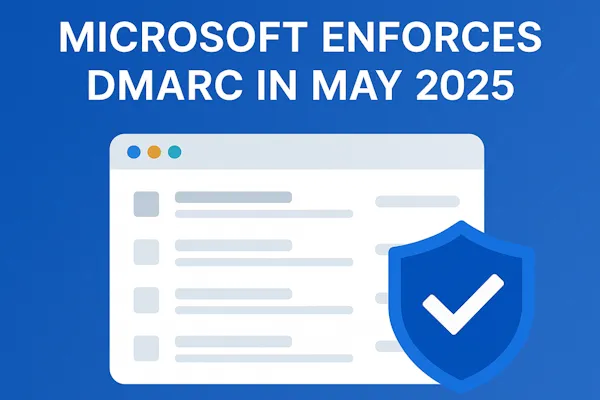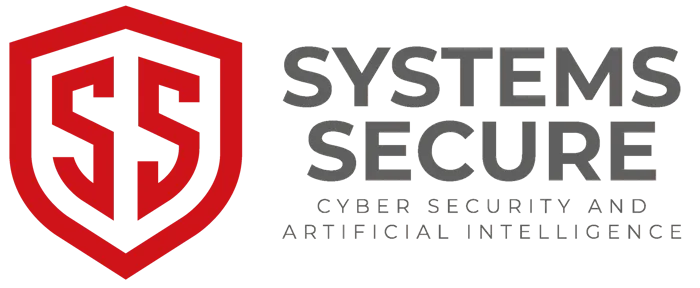Blog
Welcome to the Systems Secure Blog — your go-to resource for practical, no-fluff cybersecurity advice tailored for business owners and managers. Whether you're running a growing team or working with outsourced IT, we break down complex cyber risks into plain language and give you real-world solutions to protect your business, data, and reputation. From compliance guides and threat insights to expert tips on keeping your systems secure, we’ve got you covered.
🔒 Real advice. No jargon. Just smart, secure business.

Microsoft Enforces DMARC in May 2025: What You Need to Know
Microsoft DMARC Enforcement: Why It’s Happening
If you're a business sending emails to customers or partners, heads up: Microsoft is enforcing DMARC policies starting May 2025. And no, this isn’t just another tech update. This is a major move in the fight against email spoofing, phishing, and impersonation attacks.
But before panic sets in—breathe. You’re here, and we’ll break it down step by step.
Wait, What Is DMARC Again?
Let’s rewind.
DMARC stands for Domain-based Message Authentication, Reporting and Conformance. It builds on SPF (Sender Policy Framework) and DKIM (DomainKeys Identified Mail), helping domain owners tell email providers what to do with unauthenticated messages.
In short:
✅ Legit emails get through
❌ Spoofed emails get blocked or marked as junk
Why Is DMARC Important?
It protects your brand from impersonation
It improves email deliverability
It gives you visibility into who's using your domain to send emails (yep—even malicious actors)
What Exactly Is Microsoft Changing?
Until now, Microsoft Outlook and Exchange Online might have ignored or softened DMARC failures, especially if the domain had a p=none policy.
But starting May 2025, Microsoft will:
👉 Respect DMARC policies fully
👉 Enforce p=quarantine and p=reject as instructed
👉 Block or filter emails that fail SPF/DKIM and don’t align with DMARC
This means legitimate emails that aren't properly authenticated could land in spam—or get bounced entirely.
What Happens If You Do Nothing?
Honestly? Not good.
Here’s what could happen:
Emails from your domain may never reach inboxes
Important communications could go to spam or junk
Your brand might appear untrustworthy
You’ll lose visibility over who’s spoofing your domain
If you haven’t implemented DMARC yet, now’s the time to act.
How to Prepare for Microsoft’s DMARC Enforcement
Good news—preparing isn’t rocket science. But it does take a few technical steps:
1. Set Up SPF and DKIM
You can’t enforce DMARC without the foundation. SPF and DKIM records should:
Include all your legit sending services (like Mailchimp, Google Workspace, M365)
Be properly formatted and free of syntax errors
Be regularly tested
Use tools like MXToolbox or DMARC Analyzer to validate your setup.
2. Publish a DMARC Record
Start with a gentle approach:
v=DMARC1; p=none; rua=mailto:[email protected];This policy won’t block anything yet, but it collects reports showing who’s sending emails on your domain’s behalf.
3. Monitor & Analyse DMARC Reports
Those reports can look like gibberish, but services like:
…translate them into readable dashboards. Watch for:
Unknown sources sending on your behalf
Legitimate services that need SPF/DKIM adjustments
4. Gradually Enforce DMARC (Quarantine → Reject)
Once you’re confident everything is configured correctly, raise the policy to:
p=quarantine– suspicious emails go to spamp=reject– suspicious emails are blocked entirely
Pro tip: Do this gradually, over several weeks, with continued monitoring.
5. Review Third-Party Senders
Any CRM, invoicing tool, or marketing platform that sends email as you needs:
Your DKIM key published on their behalf
An SPF include in your DNS
If they’re not configured right, their emails will fail DMARC.
Microsoft DMARC Enforcement: What It Means for Your Business
If you’re in IT, marketing, or compliance, this change touches your world. Here's how:
IT Teams: Must ensure SPF/DKIM/DMARC alignment
Marketing Teams: Risk broken campaigns if email deliverability tanks
Compliance Teams: Email fraud prevention supports regulatory standards like ISO 27001, PCI DSS, and NIS2
How Systems Secure Can Help
At Systems Secure, we’ve helped dozens of clients roll out full DMARC compliance—from audit to enforcement. Whether you’re a small business or a growing enterprise, we can:
Assess your current DNS/email setup
Configure and monitor SPF, DKIM, DMARC
Provide hands-on support with DMARC tools
Contact us at 07588 455611 or [email protected] to secure your email reputation today.
Summary: Don’t Wait Until May
Microsoft’s DMARC enforcement is coming. Here’s what to do now:
✅ Get your SPF, DKIM, and DMARC records in order
✅ Monitor reports using a reliable DMARC dashboard
✅ Work toward p=reject by May 2025
✅ Review third-party senders for alignment
✅ Reach out for help if it’s confusing
This is your chance to reduce phishing, boost deliverability, and protect your brand.

Quick Links
©Systems Secure 2025
All Rights Reserved





